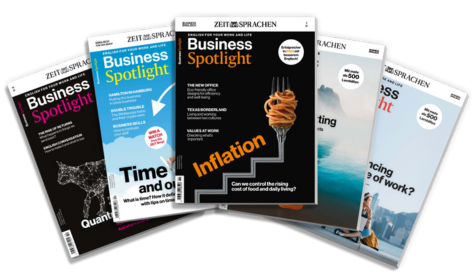Not all workplace presentations are long, formal talks given to large external audienceZuhörer(innen)audiences. Many are short, internal presentations that take place within a regular team meeting or a meeting of head of departmentAbteilungsleiter(in)heads of departments. Such presentations often to outline sth.etw. (kurz) darstellenoutline a problem, present results or simply to provide an updateeinen aktualisierten Überblick über etw. gebenprovide an update about the status of a project.
Useful phrases for internal presentations
A. Giving background information
- I’d like to talk to you about our/the… project.
- This shouldn’t take more than about… minutes.
- We started this project… weeks/months ago.
- As you know, this is a key project.
- This project will enable us to…
- As you (probably) know, we’re now in stage… of this project.
- We’ve already started the main part of stage…
B. Giving updates
- As you might remember, we had some problems with…
- However, we’ve to encounter sth.auf etw. stoßenencountered some problems.
- Unfortunately, we haven’t been able to…
- We haven’t solved this issueProblemissue yet.
C. Checking understanding by asking questions
- Is everyone with me so far?etwa: Ist so weit alles klar?Is everyone with me so far?
- Is that clear?
- Do you follow me?
- Do you see what I mean?
- Does that make sense?
- Are there any more/further questions at this point?
- Shall I go through those figures again?
D. Asking for support
- I need some help with…
- I need some help in getting…
- Does anyone know how to… ?
- Can you please talk to… ?
E. Talking about the next steps
- Our next step needs to be…
- We need the support of…
- Can we extend the current deadline(s)?
- I’m sure we can to get back on schedulewieder im Zeitplan seinget back on schedule soon.
- Let’s to follow up(die Sache) weiterverfolgenfollow up individually after this meeting.
Questions
As you read Ulrike’s presentation below, think about the answers to these questions:
- How does Ulrike make sure that everyone can follow her from the beginning?
- What does Ulrike say in order to get others to focus on her news about the project?
- How does Ulrike turn her focus to the future of the project?
Presentation
Ulrike: Hi, everyone. OK, so I’d like to talk to you about our Ming project. This shouldn’t take more than about ten minutes. As you know, this is a key project, which will enable us to increase our capacity to three times what it was five years ago. We started this project two months ago and, as you probably know, we’re in stagePhasestage three now. The graphgrafische Darstellunggraph on this slideFolieslide shows you an overview of our history and current capacity in our department. Is everyone with me so far?
Isabelle: Yes.
Pierre: Sure.
Ulrike: Great. We’ve finished the preparation and we’ve already started the main part of stage three. However, we’ve encountered some problems in getting information from the other departments. It’s either not coming or it’s coming very late and this is to affect sth.etw. beeinträchtigenaffecting our timelineZeitrahmen, -plantimeline. Unfortunately, we haven’t been able to complete all the reporting tasks we wanted to. We haven’t solved this yet and must find a solution. Our next step needs to be something that creates more collaboration on this project. Do you follow me?
Martin: Yes, I think so.
Ulrike: We need the support of all departments. Otherwise, we’ll continue to to run latein Verzug seinrun late and no one will benefit. Do you see what I mean?
Isabelle: OK. You have a to have a pointnicht ganz unrecht habenpoint. So what do you need?
Ulrike: I’m glad you asked. I need some help in getting the information from the other departments. Can you please talkVortragtalk to the department heads about this?
Isabelle: Sure, no problem. I wasn’t aware there’s an issue.
Ulrike: Thanks. Also, can we extend the current deadline for this stage by a couple of weeks? If we can get the information we need quickly, I’m sure we can get back on schedule soon.
Pierre: I don’t see why not. Let me to look into sth.etw. überprüfenlook into it for you.
Ulrike: Great, thanks. So, that was my update on the Ming project. Let’s follow up individually after this meeting.
Grammar
Using the present perfect for project updates
When giving people updates on projects, we often use the present perfect to talk about what has or hasn’t been done since the last meeting or update. The present perfect is formed with “have” + past participle. Look at these examples from the dialogues:
- We’ve already started the main part of stage three.
- We’ve encountered some problems.
- We haven’t been able to complete…
- We haven’t solved this issue yet.
The present perfect is often used together with adverbials such as “already” (schon), or “not yet” (noch nicht).
Answers
Here are the answers to the three questions we asked. Select the questions to read the answers.
1. How does Ulrike make sure that everyone can follow her from the beginning?
Ulrike gives the others some background information and context. She also uses visual support to help get her message across, and asks the others whether they are following her.
2. What does Ulrike say in order to get others to focus on her news about the project?
Ulrike talks about what has and hasn’t been done since the last meeting.
3. How does Ulrike turn her focus to the future of the project?
Ulrike says what she will do next and talks about the support she needs.
Neugierig auf mehr?
Dann nutzen Sie die Möglichkeit und stellen Sie sich Ihr optimales Abo ganz nach Ihren Wünschen zusammen.



